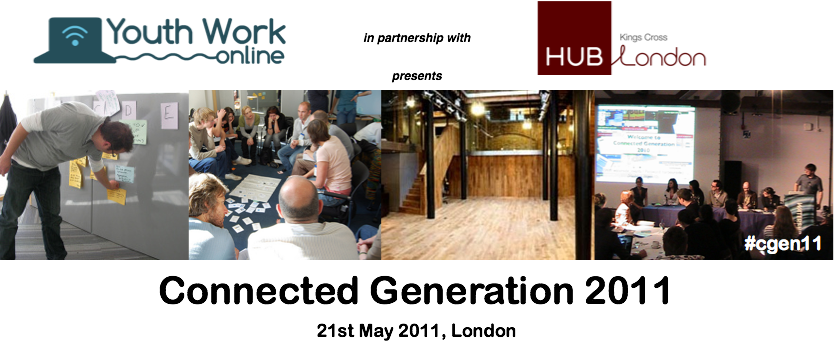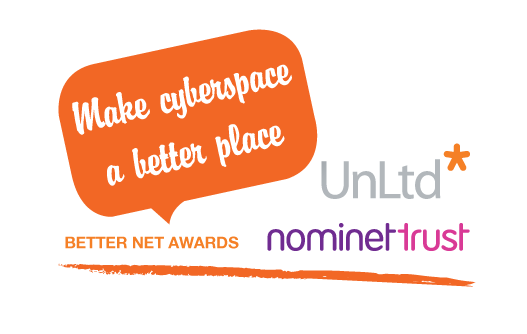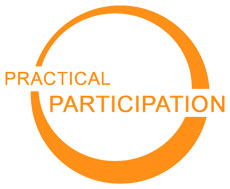I’m just coming to the end of the formal Youth Work Online Month of Action where I’ve been working to explore ways of taking forward action to promote digital skills, literacy and practice amongst professionals and volunteers working with young people. Lots to blog about it in the coming weeks, but for now I just wanted to let you know about the most important bit of the month, which, due to somewhat slack organisation on my part, is in fact taking place on the 21st May rather than this weekend: Connected Generation 2011 – the annual free unconference of the Youth Work Online network – open to anyone working with young people wanting to explore digital dimensions of their work.
Booking is now open – and more details are below…

The annual event for anyone exploring digital dimensions of work with young people.
The Connected Generation unConference is back for 2011 on 21st May at The Hub Kings Cross, London.
This one-day free open space event brings together practitioners from youth work, participation and voluntary youth projects with digital media developers and experts to share ideas and practice, to explore what the digital world means for young people’s lives, and for services seeking to support young people as they navigate growing up in a connected world.
The agenda for the event is set on the day, and built around the ideas, experiences and questions that participants bring. Topics at past events have included: understanding young people’s digital media use; creating an online presence for your youth project; digital literacy; keeping young people safe online; creating policies and guidance for practitioners; social media tips and tricks; identifying the right tools for the job; social media for youth participation and local democracy; building websites with young people; virtual volunteering; mobile technology for youth work; and much more.
This years event is running in partnership with social innovation specialists Hub Kings Cross and is hosted at the inspiring Hub venue in central london (2 minutes walk from Kings Cross Tube and Railway station), and offers new opportunities to connect digital youth work themes with ideas of social enterprise and innovation.
Comments from participants at Connected Generation 2010:
- “Great event, good organic feel to it, how conferences should be!”
- “A brilliant opportunity to find out about what other professionals and young people are doing with social media.”
- “A real get together of great knowledge from great people!”
- “Inspiring”
New to open space events?
An unConference is created by the participants – and it works best when everyone comes prepared to offer a session. Your session could be a short presentation of a project you have recently worked on using digital media for youth engagement; or it could be a topic for discussion; or an issue you want to get the insights of others on.
When you register you have the opportunity to suggest a session you may offer; and on the day Tim Davies will facilitate an agenda setting session where we gather together ideas for sessions. We will then break out into spaces around the Hub Kings Cross
If you’re never been to an unConference before and are wondering what to expect – here is a rough outline of what the day might look like:
- 10.00am – Arrive, coffee and introductions
- 10.30am – Suggesting Sessions – participants will be invited to announce and introduce sessions they would like to run during the conference. These will be assigned to a time-slot and break-out room. There will be around 6 break out spaces, allowing 30 different sessions to take place during the day.
- 11.00am – Parallel Session 1 – some of the sessions just announced will take place and you can choose which to take part in.
- 11.45 – Parallel Sessions 2 – more sessions taking place
- 12.30 – Lunch – Pizza & salad
- 13.15 – Parallel Sessions 3 – more sessions taking place
- 14.00 – Parallel Sessions 4 – more sessions taking place
- 14.45 – Break and review – A change to check if any new ideas for sessions have arisen throughout the day so far, and to plan in a few extras
- 15.00 – Parallel Sessions 5 – a last round of sessions
- 15.45 – Plenary – come back together to share learning from the day and present findings to our invited panelists.
- 16.45 – Close
You will get to take part in at least five sessions on key topics in youth engagement and new technology. You are free to move between Open Space sessions – using ‘The Law of Two Feet’:
- If you are not contributing to, or taking anything away from a session, you may find there is another discussion you can move to;
- If you find a topic you want to discuss is not being covered, you have to opportunity to suggest a new session to explore it – and the facilitators will do their best to make your new session idea take place.
We usually end the day at a local coffee shop or pub for those who can stay in London a bit longer. Coming to London the night before? Post in the Youth Work Online forum to find other people to meet up with?
Logistics
Location
The event is talking place at Hub Kings Cross – easily accessible from Kings Cross and St Pancras mainline and underground stations, and on major bus routes. Full directions are available here. Check thetransport for London website in advance for notice of any tube closures on the day of the event.
Lunch
Lunch is provided and will include meat and vegetarian options. If you have any other special dietary requirement please let us know. If you can, do bring a dessert to share – pack of scrummy biscuits or cake(s).
WiFi
There is WiFi available through the venue. Details will be available on the day.
Twitter Hashtag & Online Network
We’re using #cgen11 as the Twitter hashtag for the event.
Notes, photos and video from the event can be posted at: http://www.youthworkonline.org.uk
Questions & Contact Details
Before the event you can contact us via tim@practicalparticipation.co.uk or info@katiebacon.co.uk
Sponsors
This event is taking place as part of the Youth Work Online Month of Action supported by a Nominet Trust UnLtd Better Net Award.

The event is taking place in partnership with Hub Kings Cross.

The event has been sponsored by:
Online Youth Outreach

Practical Participation

More Open

 When I started out researching
When I started out researching 





 Over the last year and a bit I’ve been doing less work on youth engagement and civic engagement processes than I would ideally like. I’m fascinated by processes of participation, and how to design activities and frameworks within which people can actively influence change on issues that affect them – getting beyond simply asking different groups the question ‘what do you want?’ and then struggling to reconcile conflicting answers (or, oftentimes, simple ignoring this input), to create spaces in which the different factors and views affecting a decision are materialised and in which those affected by decisions get to engage with the real decision making process. I’ve had varying levels of successes doing that – but the more time I’ve been spending with public data – the more I’ve been struggling to work out how to bring it into participative discussions in ways that are accessible and empowering to participants.
Over the last year and a bit I’ve been doing less work on youth engagement and civic engagement processes than I would ideally like. I’m fascinated by processes of participation, and how to design activities and frameworks within which people can actively influence change on issues that affect them – getting beyond simply asking different groups the question ‘what do you want?’ and then struggling to reconcile conflicting answers (or, oftentimes, simple ignoring this input), to create spaces in which the different factors and views affecting a decision are materialised and in which those affected by decisions get to engage with the real decision making process. I’ve had varying levels of successes doing that – but the more time I’ve been spending with public data – the more I’ve been struggling to work out how to bring it into participative discussions in ways that are accessible and empowering to participants.

